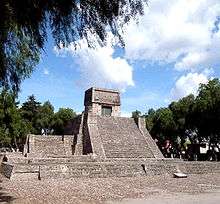Aztec philosophy
Aztec philosophy was a school of philosophy that developed out of Aztec culture. The Aztecs had a well-developed school of philosophy, perhaps the most developed in the Americas and in many ways comparable to Ancient Greek philosophy, even amassing more texts than the ancient Greeks.[1] Aztec cosmology was in some sense dualistic, but exhibited a less common form of it known as dialectical monism. Aztec philosophy also included ethics and aesthetics. It has been asserted that the central question in Aztec philosophy was how people can find stability and balance in an ephemeral world.[2]
Beliefs
Aztec philosophy saw the concept of Ometeotl as a unity that underlies the universe. Ometeotl forms, shapes, and is all things. Even things in opposition—light and dark, life and death—were seen as expressions of the same unity, Ometeotl. The belief in a unity with dualistic expressions compares with similar dialectical monist ideas in both Western and Eastern philosophies.[2]
Relation to Aztec religion
Aztec priests had a panentheistic view of religion but the popular Aztec religion maintained polytheism. Priests saw the different gods as aspects of the singular and transcendent unity of Teotl but the masses were allowed to practice polytheism without understanding the true, unified nature of their Aztec gods.[2]
Moral beliefs and aesthetics
Aztec philosophers focused on morality as establishing balance. The world was seen as constantly shifting with the ever-changing teotl. Morality focused on finding the path to living a balanced life, which would provide stability in the shifting world.[2]
Aztec philosophy saw the arts as a way to express the true nature of teotl.[2] Art was considered to be good if it in some way brought about a better understanding of teotl.[2] Aztec poetry was closely tied to philosophy and often used to express philosophic concepts.[2][3] Below is an example of such a poem, translated from the original Nahuatl:
No one comes on this earth to stay
Our bodies are like rose trees -
They grow petals then wither and die.
But our hearts are like grass in the springtime,
They live on and forever grow green again.
Texts
There is a dearth of material from which Aztec philosophy can be studied with a majority of extant texts written after conquest by either Spanish colonists and missionaries, or Christianised Spanish educated natives. Pre-conquest sources include the Codex Borgia and the Codex Borbonicus (written about the time of conquest). Post-conquest texts include the Florentine Codex, Codex Mendoza and the Codex Magliabechiano, including others.[4]
See also
- Tlacaelel
- Government of the Aztec Empire
- Indigenous American philosophy
- Mesoamerican literature
References
- Mann, Charles C. 1491: New Revelations of the Americas Before Columbus. New York: Alfred A. Knopf, 2005. p, 121.
- James Maffie (2005). "Aztec Philosophy". Internet Encyclopedia of Philosophy.
- Mann, 122-123
- "Aztec Philosophy - Internet Encyclopedia of Philosophy". www.iep.utm.edu. Retrieved 8 April 2018.
Sources:
- Maffie, James; Aztec Philosophy: Understanding a World in Motion; 2014 : NDPReview.
- Leon-Portilla, Miguel; Native Mesoamerican Spirituality; Jun 27 2002.
- Leon-Portilla, Miguel; Aztec Thought and Culture: A Study of the Ancient Nahuatl Mind; 1990.
- Leon-Portilla, Miguel; Fifteen Poets of the Aztec World; October 15, 2000.
